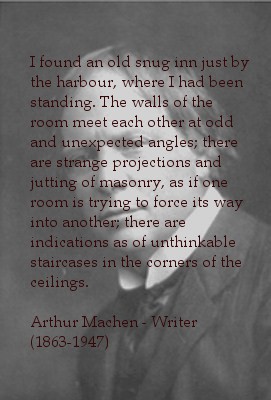One damp, grey February morning I resolved to visit the ancient road over Wheeldale Moor, it seemed high time I did an item about this strange, enigmatic structure. Unfortunately I didn't have my hiking boots with me, they were in my wife's car boot, so although I was suitably attired for the prevailing drizzle, sadly I was poorly shod against the perils of sodden ground.
 |
The course of the road, with Hunt House to the
north and Wheeldale Bridge to the south |
After driving through Goathland from Whitby I turned onto the moor and took a left turn down Hunt House Road. Pulling up in a layby where the pathway marked 'Roman Road' leads off, I sat and had some lunch and a cup of flask tea. The mist was rolling in over the moorland horizon and the sky was an austere grey. Ideal weather for viewing ancient monuments.
The path led through a meadow and across a wooden bridge over a fast flowing stream, then a track continued up through a field at a moderate gradient. This is where my less than adequate footwear caused a bit of bother. It was very wet and slippery and by far the easiest way was to walk on the grass at the side of the track.
After a bit of mud skating and almost falling down several times, a gateway led out onto the edge of the moor. A notice board explaining the legend of Wade, a map of the road's route and a couple of diagramatic cross sections had been erected in a large puddle. Luckily some kind soul had placed a plank across the water so I balanced on it precariously and read the informative text. One of the illustrations showed Wade himself actually lifting a huge stone to build the road so his wife Bell could herd her sheep over the moorland pastures.
 |
| The first part of the Wheeldale road as it rises from Hunt House onto Wheeldale moor |
The course of the road leading from here is made of sandstone slabs set amongst rough grass on a low embankment. Once these stones obviously formed the metalled surface layer. Stones are set on their sides along some parts of the edges of the road forming a kerb. A layer of gravel laid over the closely fitted sandstone slab metalling once formed the upper surface, and presumably the kerbstones helped to keep this in place, as well as preventing the sandstone slabs from sliding off their embankment.
It gently curves and rises before a wall crosses the road. From thenceforth the landscape changes to heather moorland and the road can be seen disappearing in the mist as it heads toward Wheeldale Bridge. Low clouds ominously rolling over the coniferous woodlands on the horizon and the remoteness of the location add to the overwhelming sense of mystery and wonder, because the construction of this ancient carriageway must have been a collossal undertaking.
In places where streams cross the route, the channels are bridged by stones from the road. Also it's quite clear that metalling slabs have been used in the building and repair of many nearby drystone walls.
 |
| Stones from the road used to bridge a stream |
The work to expose the road as we see it now was undertaken by Mr James Patterson between 1912 and 1920 on behalf of the Office of Works. He found no pottery or coins during the course of his work. In fact the only relics he came across were human remains, described as a contracted skeleton, discovered in a small roadside burial cist made of slabs set on edge then covered by a large, flat stone. The remains found by Patterson and the coverstone to this cist have long since disappeared.
Although often called a Roman road, the actual date of construction has been the subject of much debate. In many ways it doesn't fit the typical profile of a Roman road. It has been suggested that it may even be part of a Neolithic boundary of some sort.
 |
| Over the heather towards Wheeldale Bridge |
The following extract from a letter by Stockton based archaeologist Blaise Vyner published in British Archaeology, no 29, November 1997, serves to illustrate the lack of clarity about its origins, even amongst experts.
'I should like to comment on the 'road' across Wheeldale Moor, which you illustrated on the front cover. This structure is often referred to as one of the best surviving instances of unaltered, though robbed, Roman road construction. However, apart from being roughly on a line drawn between Cawthorn Roman camps and the Roman fortlet on Lease Rigg, it has none of the characteristics of a Roman road. It is restricted to Wheeldale Moor, and follows a sinuous course. It is also broken by watercourses. For some time I have suspected that this monument is in fact a Neolithic or Early Bronze Age boundary line'
As the ground became more and more sodden due to the constant drizzle, I decided that it was time to call it a day and retreat back to civilization. The purchase my relatively smooth soled shoes were obtaining on the slippery, lichen clad rocks, wet heather and couch grass was growing ever more tenuous. It would have only been a matter of time before I was face down in a peaty puddle with a mouthful of sphagnum moss.
Clearly I need to go up there again, but wearing more appropriate footwear and possibly another jumper. I would however feel somehow cheated if a warm sun was shining in the sky and bees were busy collecting pollen in the blooming heather. Ancient and mysterious monuments require a cloak of swirling mist and a penetrating wind that keeps everyone but the most intrepid visitors away.
Link to the full text of Blaise Vyner's letter












